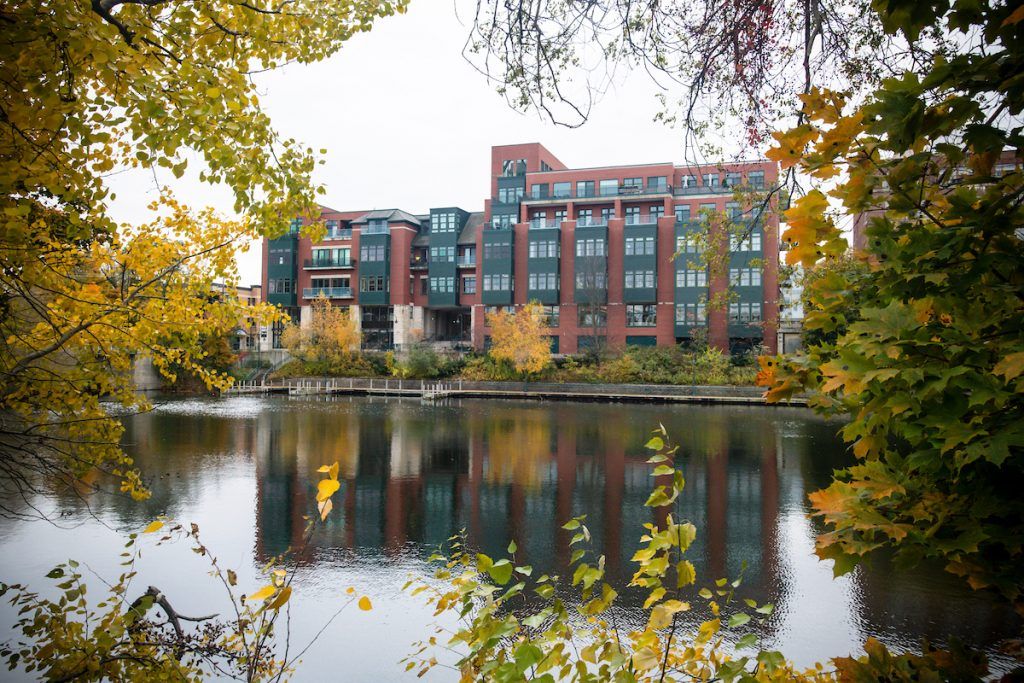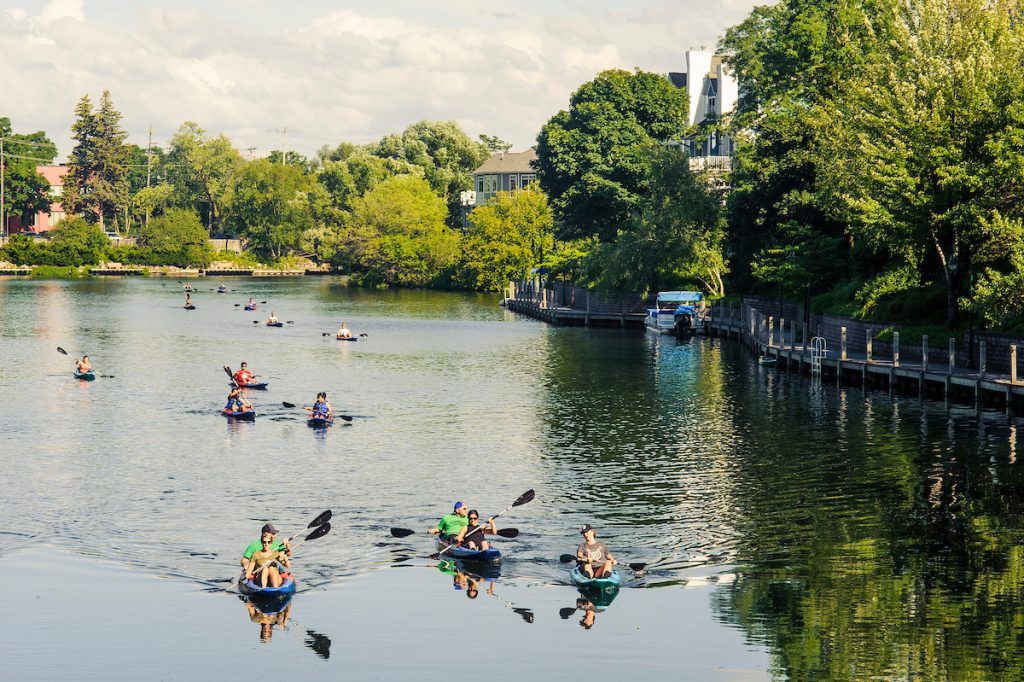
Lower Boardman River Unified Plan
In 2018, the DDA, in cooperation with a community-led Leadership Team, initiated a planning process to develop a comprehensive plan for the 1.6 miles of the Boardman River that meanders through Downtown. To date, the Leadership Team has worked to complete a comprehensive inventory and understanding of the rivers conditions (above and below the surface), identified through extensive civic engagement, guiding values and a general vision for the future of the river. The Unified Plan is now available for review (see below)!
Unified Plan
Unified Plan Appendices
Brief History of the Boardman
The Boardman River has a long and rich history. Originally called the Ottaway River, the river was used (and cherished) by indigenous people for transportation and sustenance for hundreds of years. European settlers, including Captain Harry Boardman, moved into the area in the 1800’s and used the river to move cut timber from the surrounding region. While vital to the economic growth of the region, the logging industry devastated the rivers aquatic habitat. After the logging era, several dams were constructed along the river to provide power to the region. The last of these dams was decommissioned in 2005. For the last 15 years, under the Boardman River Dams Ecosystem Restoration Project, local leaders are working to remove the remaining dams and reconnect over 160 miles of free-flowing river.



Your Boardman Leadership Team
Jennifer Jay, The Grand Traverse Land Conservancy – Co-Chair
Brett Fessell, Grand Traverse Band of Ottawa and Chippewa Indians – Co-Chair
Sammie Dyal, Grand Traverse Band of Ottawa and Chippewa Indians
Russ Soyring, City of Traverse City Resident
Frank Dituri, City of Traverse City
Tim Werner, City of Traverse City Commissioner
Jean Derenzy, Downtown Development Authority
Christine Crissman, The Watershed Center
Rick Korndorfer, Downtown Property Owner
Pete Kirkwood, Downtown Business Owner and DDA Board Member
Elise Crafts, Business Owner
Mike Vickery, City Resident
Deni Scrudato, City Resident
Shawn Winter, City Planner for City of Traverse City
PROJECT CONSULTANT
Bob Doyle, from SmithGroup, is the primary consultant charged with helping the The Leadership Team develop, facilitate and complete the Unified Plan.
Civic Engagement
The Leadership Team has (and will continue to) facilitated a robust civic engagement process throughout the planning process. Listed below is a list of civic engagement activities to date:
Unified Plan Development & Adoption Process

FAQs
Why Are We Creating a Plan for the Lower Boardman?
For many years, Downtown Traverse City had turned its back to the Boardman River. However, over the last 15 years, the city and DDA have installed a number of public access projects (e.g., new boardwalks, fishing landings, pedestrian bridges) along the Lower Boardman River. Unfortunately, many of these amenities were not connected, leaving a disjointed system of pedestrian paths, landing areas and dead-ends. At the same time, there have been a number of new infill developments along the river, sparking debate about the appropriate use of land along the river. A Unified Plan for the Lower Boardman River will – for the first time – provide a cohesive vision for the river corridor, as well as steps to address land use, public access, infrastructure, culture and habitat.
Who Is In Charge of Developing This Plan?
The DDA initiated the development of a “Unified Plan” for the Lower Boardman River. The DDA appointed the Lower Boardman Leadership Team (a sub-committee of the DDA) to lead the planning process. The Leadership Team includes 13 members, made up of local officials (including the City Commission and DDA) , government staff, a member of the Grand Traverse Band of Ottawa and Chippewa Indians, representatives from stakeholder organizations, businesses owners, residents and citizens. In leading the planning process, the LBLT hosts and facilitates monthly planning meetings, directs plans for civic engagement and outreach, presents updates/findings to the DDA, City Commission and other relevant boards/commissions, and is charged with the plan’s content.
What Part of the River is considered the “Lower Boardman”?
The Lower Boardman River and scope of this plan encompasses the 1.6 miles of the Boardman River that meanders through Downtown – from the northern shore of Boardman Lake to Lake Michigan.
Is There Anyone Helping Develop This Plan?
The DDA, in partnership with the Lower Boardman Leadership Team, is working with SmithGroup (a planning consultant) to help facilitate public engagement and develop the plan.
How Is This Plan Related to the FishPass Project?
The FishPass (and Union Street Dam) Project has already been approved and is being facilitated by the US Army Corps of Engineers, in partnership with the Great Lake Fishery Commission, the city and many others. Although the portion of the River where the new FishPass will be located is within the geographic scope this project, the Leadership Team does not have any authority to interfere with the FishPass Project. The final Unified Pan for the Lower Boardman will acknowledge the FishPass project and opportunities for connectivity.
How Is This Planning Effort Related to the Draft Riparian Buffer Ordinance?
The draft riparian buffer ordinance is being developed by the city planning commission and includes proposed regulations for areas of the city adjacent to water including Lake Michigan, Boardman Lake, Kids Creek and the Lower Boardman River. In a separate but parallel effort, and because it was asked, the Lower Boardman Leadership Team has developed recommendations for the draft Riparian Buffer Ordinance as part of this planning effort. These recommendations must be approved by the DDA board and then sent on to the Planning Commission for their consideration. These recommendations will also be included in the final Unified Plan.
When Will the Plan Be Completed?
The Leadership Team is currently working to finish its final draft recommendations. Once the Leadership Team is ready, they will present the final draft recommendations for pubic comment and discussion. Much like the first round of civic engagement, the Leadership Team will facilitate robust and thorough public discussion on the draft recommendations. Due to the COVID pandemic, we expect these discussions will happen virtually as well as face-to-face as permitted. It is anticipated the draft recommendations will be ready for review and discussion in May and June of 2021. Based on community feedback, the Leadership Team will develop the final recommendation and complete the Unified Plan. The Plan will then be presented for